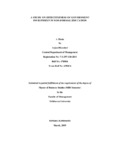Please use this identifier to cite or link to this item:
https://elibrary.tucl.edu.np/handle/123456789/1033| Title: | A Study on Effectiveness of Government Investment in Non-Formal Education |
| Authors: | Bhandari, Arjun |
| Keywords: | Public Finance;Non-formal Education;Literacy Rate |
| Issue Date: | 2019 |
| Publisher: | Central Departmental of Management |
| Abstract: | This study has investigated on A study on Effectiveness of Government investment in non-formal education. It focused on public finance role in the country. It aimed to evaluate the effectiveness of the non-formal education in Nepal for the periods 2070/71 to 2074/75. The research has attempted to assess the extent to which the effectiveness of non-formal education in Nepal by the comparing with literacy rate, HDI, and number of participation person in the program. Data are collected and used secondary data from the budget speech of government of Nepal, reports of non-formal education center and flash reports of ministry of education. This study used descriptive and analytical research approach. Analysis has based on data extracted from budget speech, various reports of ministry of education and reports of UNDP for the relevant periods. Ratio of the budget allocation and utilization on non-formal education sector and education sector shows the trends of budget planning. The progress rate on literacy rate, HDI index and the participation on the program shows the effectiveness in investment on non-formal education budget. Correlation analyses respectively has to examine the nature and extent of the relationship between the variables and showing the relationship between non-formal education budget, literacy rate, HDI, total national budget and participation of people in the program. The study covered non-formal education in Nepal over a period of past five fiscal years from 2070/71 to 2074/75. The analysis shows the government shows in non-formal education is effective and government can increase the budget on non-formal education sector for the increasing rate of literacy and HDI indicator. Descriptive statistics is used in the analysis and findings suggest that among the planning the budget. However, the findings of this paper are based on a study conducted on the selected budget heads. Hence, the result shows that non-formal education has important factor for the increasing ratio of literacy rate, and HDI. Therefore, the results are valid for public finance sector. Key words: Public Finance, Non-formal Education, Literacy Rate, HDI |
| URI: | http://elibrary.tucl.edu.np/handle/123456789/1033 |
| Appears in Collections: | Finance |
Files in This Item:
| File | Description | Size | Format | |
|---|---|---|---|---|
| Thesis.pdf | 467.7 kB | Adobe PDF |  View/Open |
Items in DSpace are protected by copyright, with all rights reserved, unless otherwise indicated.
